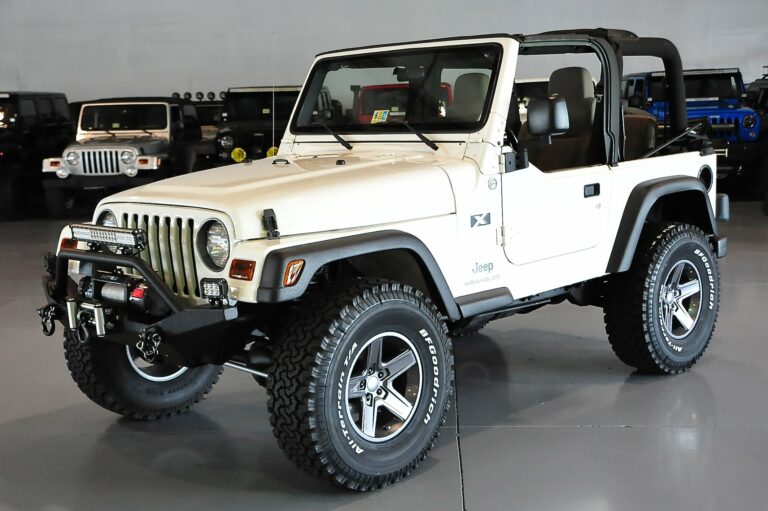M 151 Jeep For Sale: A Comprehensive Buyer’s Guide
M 151 Jeep For Sale: A Comprehensive Buyer’s Guide jeeps.truckstrend.com
Introduction: The Enduring Allure of the M151 MUTT
The M151 Jeep, officially known as the "Truck, Utility, 1/4 Ton, 4×4, M151," and affectionately nicknamed the "MUTT" (Military Utility Tactical Truck), stands as a testament to military engineering and a symbol of American history. Developed by Ford Motor Company in the late 1950s, it replaced the venerable Willys M38 and M38A1, serving as the primary light tactical vehicle for the U.S. military from the early 1960s through the 1980s. From the jungles of Vietnam to the deserts of the Middle East, the M151 saw extensive service across multiple conflicts and humanitarian missions worldwide.
M 151 Jeep For Sale: A Comprehensive Buyer’s Guide
Today, for collectors, enthusiasts, and those seeking a piece of automotive history, an M151 Jeep for sale represents more than just a vehicle; it’s a tangible link to a pivotal era. Its rugged simplicity, distinctive design, and historical significance make it a highly sought-after classic. However, acquiring an M151 is not like buying a typical used car. It involves understanding its unique characteristics, historical context, and crucial legal considerations that differentiate it from other classic military vehicles. This comprehensive guide aims to equip potential buyers with all the necessary information to navigate the exciting, yet complex, world of M151 Jeep acquisition.
The Legacy of the M151 MUTT: A Brief History
The M151 was designed to be a significant improvement over its predecessors, featuring a monocoque body (a unibody construction), independent coil spring suspension at all four wheels, and a more powerful overhead-cam four-cylinder engine. These innovations provided a smoother ride, better off-road capability, and improved performance compared to the leaf-sprung M38 series.
Over its production life, the M151 underwent several iterations:
- M151 (1959-1964): The original design.
- M151A1 (1964-1968): Minor improvements, primarily to the rear suspension and lighting.
- M151A2 (1968-1982): The most common and recognizable variant, featuring a redesigned rear suspension to reduce the tendency for rollover during high-speed cornering (a characteristic of the earlier independent rear suspension designs). It also received larger taillights.

Beyond these main variants, specialized versions included the M825 (for mounting a recoilless rifle), M718 (front-line ambulance), and others for various roles. The M151 was eventually replaced by the High Mobility Multipurpose Wheeled Vehicle (HMMWV), or Humvee, in the late 1980s.
Why Buy an M151 Jeep? Benefits and Appeal
For many, the appeal of an M151 Jeep for sale extends beyond mere transportation. Here are compelling reasons to consider ownership:
- Historical Significance: Owning an M151 is owning a piece of American military history, a vehicle that served alongside soldiers in critical moments.
- Unique Driving Experience: With its light weight, independent suspension, and manual transmission, the M151 offers a raw, engaging, and distinct driving feel unlike modern vehicles.
- Robust and Simple Design: Built for military use, the M151 is inherently durable. Its mechanical simplicity means that many repairs can be undertaken by a capable enthusiast.
- Collectibility and Investment: Well-maintained and historically accurate M151s can appreciate in value, especially rarer variants or those with documented service history.
- Community and Events: Owning an M151 connects you to a passionate community of military vehicle enthusiasts, offering opportunities for rallies, shows, and shared knowledge.
- Off-Road Capability: Despite its age, the M151’s original design made it highly capable in challenging off-road conditions.
Understanding M151 Variants and Their Impact on Value
When searching for an M151 Jeep for sale, understanding the different variants is crucial as they influence performance, parts availability, and, significantly, value.
- M151 (Original): Less common to find in good condition. May have more significant original suspension characteristics.
- M151A1: A subtle improvement over the original. Still shares many early characteristics.
- M151A2: By far the most common and generally preferred variant due to its revised rear suspension, which improves stability. If you plan to drive it regularly, the A2 is often the safest bet.
- Specialized Variants (M825, M718, etc.): These are rarer and often command higher prices due to their unique configurations and limited production numbers.
The variant directly impacts its potential street legality (especially if the A2’s suspension modifications are considered beneficial for civilian use) and the availability of specific parts.
Key Considerations Before Purchase: Navigating the M151 Market
Buying an M151 Jeep requires careful thought and research. Here are the most critical factors:
1. Legality and Registration: The M151’s Achilles’ Heel
This is the most important consideration. Due to safety concerns (specifically related to its independent rear suspension’s handling characteristics when pushed to limits by untrained drivers), the U.S. military began demilitarizing M151s by crushing their frames or cutting them into sections before selling them as scrap. The intent was to prevent them from being registered for civilian road use.
- "Demilled" vs. "Non-Demilled": Many M151s in private hands today were either obtained before the crushing mandate, exported and then re-imported, or "rebuilt" from demilled frames with new sections.
- State-by-State Rules: Registration laws vary wildly. Some states are very strict and will not allow any M151 to be registered for road use, regardless of its origin. Others are more lenient, especially if it’s registered as an "antique" or "off-road only" vehicle.
- Proof of Origin/ Demand clear title and bill of sale documentation. Be extremely wary of vehicles with "salvage" or "parts-only" titles unless you specifically intend it for off-road or display use only. A clear, transferable title is paramount for street legality.
- Legal Advice: Consult your local Department of Motor Vehicles (DMV) or a legal expert familiar with classic military vehicle registration in your state before committing to a purchase.
2. Condition and Restoration Status
M151s come in various states of repair:
- Fully Restored: These command the highest prices. Look for documented restoration processes, period-correct details, and high-quality finishes.
- Running & Driving (Original/Patina): These are great for enthusiasts who want to enjoy the vehicle as is, or undertake a rolling restoration. Inspect for rust, mechanical issues, and electrical problems.
- Partially Restored/Project: Can be a good deal if you have the skills and time. Be realistic about the effort and cost involved.
- Parts Vehicle: For donors only. Ensure the price reflects this.
3. Authenticity vs. Customization
Decide if you want a historically accurate vehicle or one modified for modern comfort/performance. Originality generally holds more value for collectors.
4. Rust and Chassis Integrity
The monocoque body means rust can be a significant structural issue, especially in the floorboards, frame rails (which are integrated into the body), and suspension mounting points. Thoroughly inspect underneath.
5. Mechanicals: Engine, Drivetrain, Electrical
- Engine (Ford 141 cu in, 4-cylinder): Check for leaks, smoke, strange noises. Test drive to assess power and smoothness.
- Transmission and Transfer Case: Ensure smooth shifting and proper engagement of 2WD/4WD.
- Suspension and Steering: Listen for clunks, feel for excessive play. The independent suspension is complex; check ball joints, bushings, and shocks.
- Brakes: Critical safety item. Test thoroughly.
- Electrical System: Check all lights, gauges, and wiring. Military wiring can be prone to issues after decades of use.
6. Documentation and Service Records
Any available history, including original manuals, past service records, or restoration logs, adds significant value and peace of mind.
Where to Find M151 Jeeps for Sale
- Online Marketplaces: Dedicated military vehicle forums (e.g., G503.com), eBay Motors, Hemmings, ClassicCars.com, Facebook Marketplace groups specializing in military vehicles.
- Specialized Dealers: Companies that focus on military surplus vehicles often have M151s. They may offer restoration services and clearer titles, but at a premium.
- Auctions: Government surplus auctions (less common for drivable M151s now), or classic car auctions.
- Military Vehicle Shows & Rallies: Excellent places to see vehicles in person, meet owners, and find leads.
- Word of Mouth: Networking within the military vehicle community can yield hidden gems.
The Buying Process: A Step-by-Step Guide
- Research and Budget: Determine your desired variant, condition, and set a realistic budget for the purchase and potential immediate repairs/registration costs.
- Locate Potential Vehicles: Use the resources above to find M151s for sale that fit your criteria.
- Initial Inquiry: Contact sellers, ask detailed questions about condition, history, title status, and recent maintenance. Request numerous photos/videos.
- In-Person Inspection (Crucial): If the vehicle seems promising, arrange an in-person inspection.
- Bring a knowledgeable friend or consider hiring a pre-purchase inspector specializing in vintage vehicles.
- Thoroughly inspect the body for rust, particularly the integrated frame rails.
- Check all mechanical components, fluids, and electrical systems.
- Verify VIN/serial numbers against documentation.
- Crucially, examine the title paperwork carefully. Does it clearly state the vehicle is for road use? Is it a clear, transferable title?
- Test Drive: Assess engine performance, transmission shifting, braking, steering, and suspension. Pay attention to any unusual noises or vibrations.
- Negotiation: Based on your inspection, negotiate a fair price. Be prepared to walk away if the price doesn’t align with the vehicle’s condition or if legal issues are unclear.
- Paperwork and Title Transfer: Ensure all documents are correctly filled out. The bill of sale should clearly state the VIN, make, model, year, and condition. Verify title transfer requirements with your local DMV beforehand.
- Transportation: Arrange for safe transport, especially if the vehicle isn’t road-legal or reliable for a long drive.
Ownership and Maintenance Tips for Your M151
- Parts Availability: While not as common as CJ Jeeps, many M151 parts are still available from specialized suppliers, military surplus stores, and online forums. Some parts may require fabrication.
- Common Issues: Be prepared for typical vintage vehicle issues: fuel system problems (clogged lines, old fuel pumps), electrical gremlins, brake issues, and wear in suspension components.
- Finding Expertise: Connect with other M151 owners or military vehicle mechanics. They are invaluable resources for advice, parts, and specialized repairs.
- Proper Storage: Store your M151 in a dry, secure location to prevent rust and degradation.
- Regular Maintenance: Follow a strict maintenance schedule, including fluid changes, lubrication, and thorough inspections.
Potential Challenges and Solutions
- Legality: The biggest hurdle. Solution: Thorough research of state laws, verification of title, and potentially only buying a vehicle already registered in your state. If street legality is non-negotiable, it may significantly narrow your search.
- Parts Availability: Challenge: Specific parts can be hard to find. Solution: Network with the community, utilize specialized vendors, and consider buying a parts donor vehicle if you have space.
- Restoration Costs: Can quickly add up. Solution: Set a realistic budget, learn to do some work yourself, and prioritize repairs.
- Specialized Mechanics: Finding someone familiar with M151s can be difficult. Solution: Utilize online communities for recommendations or be prepared to learn the mechanics yourself.
M151 Jeep For Sale: Estimated Price Guide
Please note: Prices for M151 Jeeps vary significantly based on condition, variant, originality, and crucially, legal title status. This table provides a broad estimate for general guidance. Always factor in potential registration costs and necessary repairs.
| Condition Category | Description | Estimated Price Range (USD) | Key Considerations |
|---|---|---|---|
| Project/Parts Vehicle | Non-running, significant rust, incomplete, no clear title for road use. | $2,000 – $6,000 | Requires extensive restoration; unlikely to be road legal without significant work and legal hurdles. |
| Running, Needs Work | Runs and drives, but requires substantial mechanical or body work. Title status variable. | $7,000 – $15,000 | Potential for a good driver with investment; confirm title legality for your state. |
| Driver Quality | Runs well, generally solid, minor cosmetic flaws, street legal title (often M151A2). | $16,000 – $25,000 | Good for regular enjoyment; may have some non-original parts or minor issues. Most common purchase for enthusiasts. |
| Nicely Restored | Professionally restored, good to excellent condition, mostly period-correct. Clear, road-legal title. | $26,000 – $40,000+ | Ready to show and drive; higher investment, but less immediate work. Verify quality of restoration and documentation. |
| Concours/Museum Quality | Flawless, historically accurate, original or NOS parts, documented history. | $40,000 – $60,000+ | For serious collectors; often rare variants or exceptional provenance. |
Note: M151A2 variants typically command higher prices due to improved safety features and better parts availability. Specialized variants (M825, M718) can also fetch higher prices depending on their rarity and condition.
Frequently Asked Questions (FAQ) about M151 Jeep For Sale
Q1: Is an M151 Jeep street legal?
A1: This is the most complex question. Many M151s were demilitarized (cut up) by the U.S. government to prevent civilian road use. While some early models or those exported and re-imported may have clear titles, legality varies significantly by state. Always check with your local DMV and demand a clear, transferable title that explicitly allows for road registration in your state before purchasing. Be very cautious of "parts only" or "off-road only" titles if you intend to drive it on public roads.
Q2: What is the difference between an M151, M151A1, and M151A2?
A2: The M151 was the original. The M151A1 had minor updates. The M151A2, introduced in 1968, is the most common and sought-after variant due to its redesigned rear suspension that improved stability and reduced rollover risk compared to earlier models.
Q3: Are parts readily available for the M151?
A3: While not as abundant as for more common civilian Jeeps, many parts are still available through specialized military vehicle parts suppliers, online forums (like G503.com), and military surplus outlets. Some rarer components may require more extensive searching or fabrication.
Q4: How capable is the M151 off-road?
A4: The M151, with its independent suspension and light weight, was highly capable off-road in its day. It offers excellent ground clearance and maneuverability. However, its historical rollover concerns (especially for early variants) mean it should be driven cautiously, particularly at higher speeds or during aggressive cornering off-road.
Q5: What should I look out for regarding rust?
A5: Due to its unibody construction, rust can be structural. Pay close attention to the floorboards, integrated frame rails, and suspension mounting points. Significant rust in these areas can be very costly to repair and compromise safety.
Q6: Can I daily drive an M151?
A6: While technically possible if legally registered and in good mechanical condition, daily driving an M151 is generally not recommended. They lack modern safety features, comfort, and often have slower top speeds. They are best enjoyed as hobby vehicles for weekend drives, shows, and off-road adventures.
Q7: How much does it cost to restore an M151?
A7: Restoration costs vary widely depending on the initial condition and desired level of finish. A full, professional restoration can easily cost $20,000 to $40,000 or more, in addition to the purchase price. DIY restorations can be cheaper but require significant time and skill.
Conclusion: Driving a Piece of History
The M151 Jeep remains a fascinating and highly desirable military vehicle. For those seeking to own a tangible piece of history, an M151 Jeep for sale offers a unique and engaging experience. However, it’s a purchase that demands thorough research, particularly concerning its legal status and mechanical condition.
By understanding its history, recognizing the different variants, carefully assessing its condition, and diligently navigating the complex legal landscape, prospective buyers can successfully acquire and enjoy one of the most iconic military vehicles ever produced. Owning an M151 is more than just having a vehicle; it’s joining a community, preserving a legacy, and experiencing the raw, unfiltered spirit of a true American workhorse. With careful consideration, your M151 adventure can be a rewarding journey into the past.



